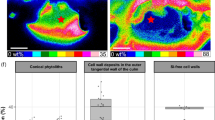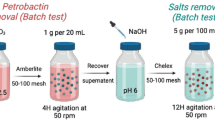Abstract
This study explored the possibility of using laser ablation inductively-coupled plasma-mass spectroscopy to measure trace metals and other elements within the annual growth layers of the teeth of walrus harvested from the Canadian Arctic. Using sample ablation “footprints” of 125 μm diameter on transects across the exposed cross-sections of teeth, this technique detected Pb, Cu, Zn and Sr, but not Cd, in tooth cementum. The micro-spatial patterns of elements were consistent among different transects on the same tooth, and revealed subtle differences between animals of different ages. The youngest walrus in the sample (4 yr) contained higher concentrations of Pb and Cu than older animals in the growth layer deposited during the first year of life, while the oldest animal (33 yr) exhibited higher Pb and Zn than younger animals in the outer layer corresponding to the year 1988. The differences between animals and across annual layers may reflect both life history and metal exposure phenomena, including high amounts of metals transferred from mothers to pups in maternal milk. The ability to detect metals in a repeatable fashion within annual growth layers suggests that metal exposure histories accurate to within a year might be re-constructed for the lifetimes of long-lived animals, and that a series of such individual studies would allow exposure histories covering centuries to be quickly assembled. These data may suggest the most likely explanation for the currently high levels of some metals observed in certain Arctic marine mammals, i.e., natural phenomenon or anthropogenic contamination.
Similar content being viewed by others
References
Blanusa M, Ivicic N, Simeon V (1990) Lead, iron, copper, zinc and ash in deciduous teeth in relation to age and distance from a lead smelter. Bull Environ Contam Toxicol 45:478–485
Boutron C, Delmas R (1980) Historical record of global atmospheric pollution revealed in polar ice sheets. Ambio 9:210–215
Braune BM, Norstrom RJ, Wong MP, Collins BT, Lee J (1991) Geographical distribution of metals in livers of polar bears from the Northwest Territories, Canada. Sci Tot Environ 100:283–299
Casselman JM, Gunn JM (1992) Dynamics in year-class strength, growth, and calcified-structure size of native lake trout (Salvelinus namaycush) exposed to moderate acidification and whole-lake neutralization. Can J Fish Aquat Sci 49:1–12
Christie SJ, Martin J (ed) (1993) Abstracts. International Symposium on the Ecological Effects of Arctic Airborne Contaminants. Reykjavik, Iceland, Oct. 4–8, 1993
Cousins RJ, Barber AK, Trout JR (1973) Cadmium toxicity in growing swine. J Nutr 103:964–972
Coutant CC, Chen CH (1993) Strontium microstructure in scales of freshwater and estuarine striped bass (Morone saxatilis) detected by laser ablation mass spectroscopy. Can J Fish Aquat Sci 50:1318–1323
Flegal AR, Maring H, Niemeyer S (1993) Anthropogenic lead in Antarctic sea water. Nature 365:242–244
Fuge R, Palmer TJ, Pearce NJG, Perkins WT (1993) Minor and trace element chemistry of modern shells: a laser ablation inductively coupled plasma mass spectroscopy study. Appl Geochem Suppl 2:111–116
Hillson S (1986) Teeth. Cambridge University Press, Cambridge
Jones KC, Gibbons D, Steinnes E (1993) Long-term deposition of heavy metals and trace organics to the Norwegian Arctic and Subarctic: a peat core study. In, SJ Christie, J Martin (ed) Abstracts. International Symposium of the Ecological Effects of Arctic Airborne Contaminants. Reykjavik, Iceland, Oct. 4–8, 1993
Kalish JM (1989) Otolith micro-chemistry: validation of the effects of physiology, age and environment on otolith composition. J Exp Mar Biol Ecol 132:151–178
Kuhnlein HV, Calloway DH (1977) Minerals in human teeth: differences between preindustrial and contemporary Hopi Indians. Amer J. Clin Nutr 30:883–886
Matsuno K, Kodama Y, Tsuchiya K (1991) Biological half-time and body burden of cadmium in dogs after a long-term oral administration of cadmium. Biol Trace Elem Res 29:111–123
Mehennaoui S, Charles E, Joseph-Enriquez B, Clauw M, Milhaud GE (1988) Indicators of lead, zinc and cadmium exposure in cattle: II. Controlled feeding and recovery. Vet Human Toxicol 30:550–555
Outridge PM, MacDonald DD, Porter E, Cuthbert IC (1994) An evaluation of the hazard to biota posed by cadmium in the Canadian environment. Environ Reviews 2:91–107
Purchase NG, Fergusson JE (1986) Lead in teeth: the influence of the tooth type and the sample within a tooth on lead levels. Sci Tot Environ 52:239–250
Richner P, Evans D (1993) Automated laser ablation sampling (ALAS) for ICP-MS. Atom Spec 14:157–161
Skoryna SC (ed) (1981) Handbook of stable strontium. Plenum Press. NY. 644 pp
Smith TG, Armstrong FAJ (1975) Mercury in seals, terrestrial carnivores, and principal food items of the Inuit, from Holman, NWT. J Fish Res Board Can 32:795–801
Steadman LT, Brudevold F, Smith FA, Gardner DE, Little MF (1959) Trace elements in ancient Indian teeth. J Dent Res 38:285–292
Wagemann R (1989) Comparison of heavy metals in two groups of ringed seals (Phoca hispids) from the Canadian Arctic. Can J Fish Aquat Sci 46:1558–1563
Wagemann R, Snow NB, Lutz A, Scott DP (1983) Heavy metals in tissues and organs of the narwhal (Monodon monoceros). Can J Fish Aquat Sci 40 (suppl. 2):206–214
Wagemann R, Stewart REA, Beland P, Desjardins C (1990) Heavy metals and selenium in tissues of beluga whales, Delphinapterus leucas, from the Canadian Arctic and the St. Lawrence Estuary. Can Bull Fish Aquat Sci 224:191–206
Wagemann R, Stewart REA, Lockhart WL, Stewart BE, Povoledo M (1988) Trace metals and methyl mercury associations and transfer in harp seal (Phoca groenlandica) mothers and their pups. Mar Mamm Sci 4:339–355
Wagemann R, Stewart R, Opinski S, Savoie D, Stewart B (1992) Lead and other heavy metals in tissues of walrus and ringed seals. In, JL Murray, RG Shearer (ed) Synopsis of research conducted under the 1991/92 Northern Contaminants Program. Environmental Studies Rep No 68. Ministry of Supply and Services Canada, Ottawa, Canada. pp 77–90
Wallach S, Chausmer A (1990) Metabolism of trace metals in animals and man: Part 1: Non-essential pollutant metals. In: Priest ND, Van De Vyver FL (ed) Trace metals and fluoride in bones and teeth. CRC Press, Boca Raton, FL. pp231–252
Wesenberg G, Fosse G, Justesen N-PB, Rasmussen P (1979) Lead and cadmium in teeth, bone and kidneys of rats with a standard Pb-Cd supply. Int J Environ Stud 14:223–230
Wesenberg G, Fosse G, Rasmussen P, Justesen N-PB (1981) Cadmium content of indicator and target organs in rats after graded doses of cadmium. Int J Environ Stud 16:147–155
Author information
Authors and Affiliations
Rights and permissions
About this article
Cite this article
Evans, R.D., Richner, P. & Outridge, P.M. Micro-spatial variations of heavy metals in the teeth of walrus as determined by laser ablation ICP-MS: The potential for reconstructing a history of metal exposure. Arch. Environ. Contam. Toxicol. 28, 55–60 (1995). https://doi.org/10.1007/BF00213969
Received:
Accepted:
Issue Date:
DOI: https://doi.org/10.1007/BF00213969




